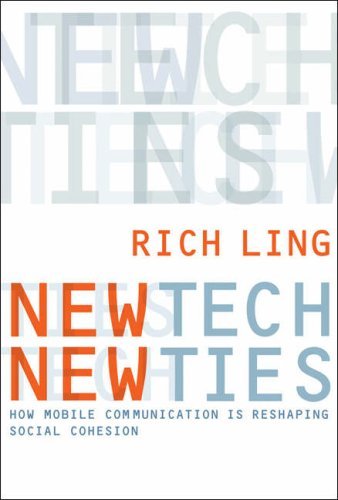New Tech, New Ties: How Mobile Communication is Reshaping Social Cohesion
Ling, Rich
MIT Press, London
2008
9780262122979 (hb)
Order this book?
 Rich Ling's newest book New Tech, New Ties raises the discussion of mobile communication to a theoretical level. It is the first serious attempt to systematically employ the sociological classics in empirically informed mobile communication research. In his book, Ling applies the theories of Émile Durkheim and Ervin Goffman, as well as the ideas of present-day theorists Randall Collins, to elucidate how mobile communication technologies reshape the patterns of social assembling. The main argument of the book is that mobile communication, despite its mundane nature, is based on ritual interaction that leads to social cohesion.
Rich Ling's newest book New Tech, New Ties raises the discussion of mobile communication to a theoretical level. It is the first serious attempt to systematically employ the sociological classics in empirically informed mobile communication research. In his book, Ling applies the theories of Émile Durkheim and Ervin Goffman, as well as the ideas of present-day theorists Randall Collins, to elucidate how mobile communication technologies reshape the patterns of social assembling. The main argument of the book is that mobile communication, despite its mundane nature, is based on ritual interaction that leads to social cohesion.
The book builds on the concept of ritual that is vividly and variously employed by sociologists. Ling's main contribution to this line of theoretical thinking is that social cohesion may also be fostered in mediated relationships. When it comes to mobile-based mediation, Ling argues, communication is replete with ritual-like gestures and practices. For Durkheim and Goffman, social cohesion takes place only in physically co-present situations. Even if Goffman, for instance, refers to the telephone at various points, he only hints at its cohesive power. Furthermore, Ling points out that also present-day sociologists, like Collins, tend to think that social cohesion requires the physical proximity of others.
To support his own argument, Ling takes advantage of an observation method similar to that of Goffman. By observing everyday use of mobile phones, he shows how people in certain repetitive manners maintain and reinforce social ties between themselves and others. Ling analyses the use of greetings, argot, humor, repartee and gossiping as ritual ways of constructing groups and bringing people together in the interaction. It is peculiar to Ling, at least in this book, that he considers ritual as an attribute of a small group. In other words, his approach is closer to Goffman than Durkheim, whose interest is most often in larger social entities.
The main message of the book is lucidly expressed. In contrast to Robert Putnam, Ling suggests that personal communication technologies work as social glue that holds people together (p.157). Whereas Putnam considers technological meditation as a major cause for decline in social capital, Ling sees mobile-mediated communication as its counter-force. In addition, Rich Ling argues forcefully - and correctly - that the mobile phone is mainly used to keep in touch with close friends and family members (p.155). It is unfortunate that the book does not pay attention to the mediation of weaker social ties such as those between acquaintances. This kind of analysis would be required to strengthen the anti-Putnam arguments of the book. Unlike strong family ties, it is the weak ties that have more potential to be bridged and to add to the total amount of social capital.
Some remarks may also be made regarding the methodology. Generally speaking, the observation method seems to produce appropriate information for the study. Even if observations are rather trivial in places, they successfully underpin the presented argument. However, the selected method is not able to reveal the entire diversity of mobile-facilitated social cohesion. Such communicative rituals that are cohesive but take place in private spaces cannot be observed without disturbing interventions. Ling's observations are all made in public places. Yet, it is very characteristics of mobile communication that people may lock themselves away with their mobile phone, and still feel a sense of belonging. Nevertheless, the absence of private mobile communication rituals cannot be counted as a major shortcoming for the book.
New Tech, New Ties is a well-reasoned account of how the mundane use of mobile phones adds to the social cohesion of small groups. Because of its solid theoretical foundations, the book is beyond compare in the field of mobile communication studies. It can be highly recommended for all interested in the interplay of social relationships and new media, and mobile phones in particular.
Sakari Taipale
University of Jyväskylä |

